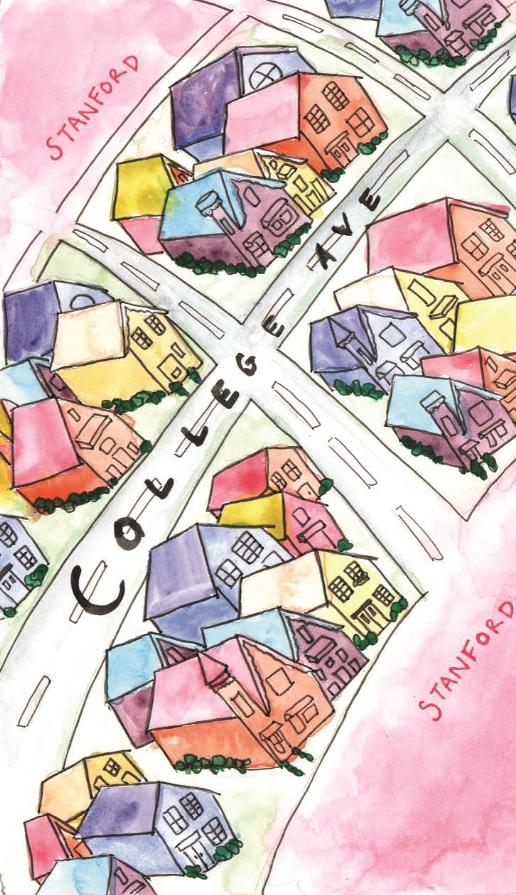One March evening, a few close friends gathered around the dinner table feasting on prime ribs, salad and carrot cake. Conversation topics varied as the meal wore on, but there was one especially prominent topic — their neighborhood, College Terrace.
Surrounded by Stanford University on all sides, College Terrace is a picturesque neighborhood two blocks in width and 12 blocks in length. Many neighbors know each other well and often gather for dinners or events.

Stanford University has been purchasing houses one by one in College Terrace since 1977, but recently there has been a noticeable increase in purchases. Now residents are unsure of what the future holds for their beloved neighborhood.
“I’d like to see the public own land in Palo Alto,” says Henry Vinton, a resident of College Terrace, “this is public land, not Stanford land, and they’ve got plenty.”
According to Palo Alto Stanford Heritage, a nonprofit organization supporting the preservation of historic Palo Alto architecture, the relationship between College Terrace and Stanford began in 1870, when a pair of German farmers who owned the land that now makes up College Terrace refused to sell to Leland Stanford.
The area then oscillated between public land and Stanford property until 1925, when the city of Palo Alto annexed College Terrace. Since then, Stanford has purchased much of the land surrounding College Terrace, leasing the land to businesses and Stanford faculty. However, it has yet to acquire the whole of College Terrace.
Eileen Stolee, another College Terrace resident, lives near three houses Stanford owns. Her biggest concern is that Stanford often leaves its College Terrace properties empty for some time.
“One of them has been empty for a year now, the other for a couple years, and the one next to me has been [empty for] almost a year. We call them ghost houses,” Stolee said.
According to a 2016 U.S. News ranking of the 10 universities with the largest endowments, Stanford is third with $22 billion. Buying land in College Terrace hardly scratches the surface of Stanford’s wealth. Sharon Murphy, a resident of College Terrace since 1971, understands this well.
“They could outright own the whole terrace if they bought every house,” Murphy says. “They can afford anything.”
Maya Homan, a Palo Alto High School senior who lives in College Terrace, hopes that Stanford is playing fair while buying up houses.
“Housing is so expensive, and Stanford obviously has a huge endowment that it can use to outbid other people,” Homan says. “So I think if there’s no one looking to buy the houses then it’s fine if Stanford buys them, but if they’re outbidding other people who just want to live and send their kids to school in a good area then they [Stanford] shouldn’t be allowed to.”
Stanford says it has no long-term goal of buying up College Terrace, and is committed to being a good neighbor to its residents.
Ernest Miranda, Senior Director of Media Relations at Stanford, told Verde in an email that Stanford staff members have met with the College Terrace Residents Association Board several times to discuss the purchasing of houses. They also addressed concerns about the creation of a new Stanford housing space just southeast of College Terrace.
Despite Stanford’s attempts to appease the residents, Murphy still believes they don’t have the neighborhood’s best interest at heart.
“I used to think Stanford was a good neighbor, but I think they’re only a good neighbor when they have to be,”
— Sharon Murphy, College Terrace Resident
“I used to think Stanford was a good neighbor, but I think they’re only a good neighbor when they have to be,” Murphy says.
According to Palo Alto Online, Stanford owned the deeds of 23 homes in College Terrace as of July 2017, but that the number of plots of land they control could be higher. This is because Stanford uses “ground leases,” Palo Alto Online reports.
Ground leases are agreements where a tenant is able to develop a property during the lease, but afterward, all property is returned to the owner, which makes it hard to tell how many houses Stanford actually owns.
Jens Jensen, the communications director for the College Terrace Residents Association, sees benefits and drawbacks in Stanford buying homes in College Terrace.
“Positive aspects are that any residents working at Stanford will reduce local traffic and parking issues,” Jensen stated in an email. “Residences in poor repair will get fixed and brought up to code. Residents will feel a responsibility also towards College Terrace and Palo Alto, in addition to feeling a responsibility toward Stanford University, perhaps a good balance.”
However, he also acknowledges the downsides of Stanford buying houses in College Terrace — one of which is how Stanford properties will not re-enter the housing market soon or ever again, reducing total potential housing stock.
Homan also voices concerns that Stanford’s expansion may detract from the neighborhood’s roots.
“I mean the whole history, the reason College Terrace exists, is because the owners refused to sell it to Stanford when it was founded,” Homan says. “I think that’s kind of a cool little part [of history]. So it’s kind of sad that that’s now being erased.”



